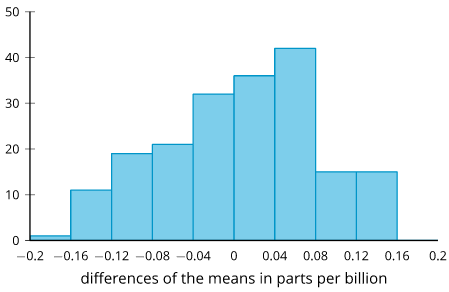Illustrative Math - Algebra 2 - Unit 7 - Lesson 16
By Formative Library
starstarstarstarstar
Last updated about 1 year ago
6 Questions
1
1.
A scientist compares methane levels on Mars at several locations, in parts per billion, taken at 2 different times during the Martian day. The difference between the means of the methane levels for the two different times is -0.08 parts per billion. The scientist uses simulations to create a randomization distribution to try to determine the likelihood that the results happened by chance. The histogram represents the results of the 200 trials from the simulations.

According to the randomization distribution, is the difference in means due to chance or the time at which the measurements were made? Explain your reasoning.
S.IC.5
S.ID.4

1
2.
1
3.
1
4.
Why do we use randomization distributions?
S.IC.5
S.ID.4
1
5.
Which of these values would be most useful for determining whether the difference in means is likely due to the treatment? Explain your reasoning.
- interquartile range
- median
- standard deviation
- range
S.IC.5
S.ID.4
1
6.
A distribution is approximately normal with a mean of 70 and a standard deviation of 10. Match the interval with the approximate percentage of data that falls within that interval.
| arrow_right_alt | 34% | |
| arrow_right_alt | 47.5% | |
| arrow_right_alt | 68% | |
| arrow_right_alt | 95% | |
| arrow_right_alt | 99.7% |
S.IC.5
S.ID.4
This lesson is from Illustrative Mathematics. Algebra 1, Unit 7, Lesson 16. Internet. Available from https://curriculum.illustrativemathematics.org/HS/teachers/3/7/16/index.html ; accessed 29/July/2021.
IM Algebra 1, Geometry, Algebra 2 is © 2019 Illustrative Mathematics. Licensed under the Creative Commons Attribution 4.0 International License (CC BY 4.0).
The Illustrative Mathematics name and logo are not subject to the Creative Commons license and may not be used without the prior and express written consent of Illustrative Mathematics.
These materials include public domain images or openly licensed images that are copyrighted by their respective owners. Openly licensed images remain under the terms of their respective licenses. See the image attribution section for more information.